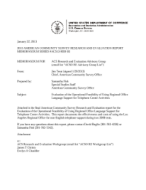
An official website of the United States government
Here’s how you know
Official websites use .gov
A .gov website belongs to an official government organization in the United States.
Secure .gov websites use HTTPS
A lock (
) or https:// means you’ve safely connected to the .gov website. Share sensitive information only on official, secure websites.
-
//
- Census.gov /
- Census Working Papers /
- Using Regional Office Language Support for Telephone Center Activities
Evaluation of the Operational Feasibility of Using Regional Office Language Support for Telephone Center Activities
Evaluation of the Operational Feasibility of Using Regional Office Language Support for Telephone Center Activities
The American Community Survey (ACS) is a continuous, national survey conducted by the U.S. Census Bureau that provides detailed demographic, socioeconomic, and housing data. The annual ACS sample is divided into 12 monthly sample panels with each panel having a three-month interview period.
Prior to 2013, a sample panel consisted of three sequential data collection modes: mail, telephone, and personal visit, each mode taking one month for completion. (This changed in 2013 to include an internet mode as the initial mode of contact.) A new panel begins each month so that all data collection modes run simultaneously throughout the year. The following paragraphs discuss the 2009 ACS methodology as it was during the time of operational feasibility testing. Most 2009 sample addresses were initially mailed an ACS questionnaire in English and given several weeks to respond. Telephone numbers for both English and Spanish speakers are listed on the paper questionnaire in case they need telephone questionnaire assistance (TQA). Respondents who call in are encouraged to complete the ACS interview over the phone, but can complete the English questionnaire they have or request a Spanish version.
In 2009, the questionnaire was only available in English and Spanish; however, an informational multi-lingual brochure was mailed as part of the initial contact to assist non-English speakers in filling out the English form (called the Multi-lingual Brochure Test). Nonrespondents in the mail mode are followed up in the telephone mode if ACS telephone vendors can match a telephone number to those sample addresses.
Three telephone centers conduct the Computer Assisted Telephone Interviewing (CATI) and the WebCATI system permits workload sharing among the centers. Interviewers dial sample addresses' phone numbers distributed to them and ask respondents to complete an ACS interview. When interviewers encounter a language barrier, they try to determine the language spoken by the respondent and record the case in the system as having a particular language need. WebCATI then dispatches these cases to an interviewer who is skilled in the appropriate language. In 2009, the call centers supported approximately 19 languages (Fish, 2010b).
It is ideal to complete as many interviews as possible by mail and telephone not only because they are less expensive, but also because only a subsample of the remaining CATI workload is passed to the personal visit mode. Approximately one in three CATI noninterviews is subsampled for personal interviewing.
Unmailable sample addresses, like those in Remote Alaska, and mail nonrespondents ineligible for CATI also become part of this the Computer Assisted Personal Interviewing (CAPI) workload. In 2009, the CAPI workload was divided among twelve regional offices in the U.S.
Others in Series
Working Paper
Working Paper
Working Paper
Share
Some content on this site is available in several different electronic formats. Some of the files may require a plug-in or additional software to view.
 Yes
Yes
 No
NoComments or suggestions?


Top

